On This Page
A Web Filing form must be completed and electronically signed online using a LTSA Enterprise account and in compliance with the directions provided in this guide.
General Guidance to Prepare and Submit a Web Filing Form
After you login to your account and create a package, you can start an application. Three key steps to prepare and submit a web filing form are outlined below.
- Complete the data entry sections to create a web filing form
- Review, print and e-sign the form in compliance with the statutory requirements of Land Title Act Part 10.1
- Click Submit Package to submit the package immediately or click Prepare Submission in EFS to send your package to EFS where you can add files (PDF Templates or Web Filing) or defer a submission.
The content in this guide sets out practice direction and guidance for completing each data entry section in a web filing form. It does not provide step-by-step instruction of the functional components in the data entry sections (i.e. features and functions of buttons and menus on the page). To learn about the functional components of the page, please see Web Filing in LTSA System Help.
General Practice Guidance
| 1.1 | The name of the donor in the Power of Attorney and the name of the registered owner must be the same. If there are variations in the names, the power of attorney document may identify the donor by all variations of their name, e.g., Mary Smith also known as Mary Jane Smith, with each name variation being stated below the donor’s execution. |
| 1.2 | A Power of Attorney cannot have alternate names for the attorney; for example, "also known as" or "aka". |
| 1.3 | Attorneys cannot execute a transfer to themselves without the Power of Attorney expressly authorizing it. |
| 1.4 | Due to privacy laws, private information (such as a driver's license number or passport number) should not be included on the Power of Attorney itself. |
| 1.5 | The attorney must sign the Enduring Power of Attorney. The requirement for the attorney to sign is not met by virtue of the attorney solely executing supporting documentation, such as a "proof of age" declaration. |
| 1.6 |
Information related to an alternate or substitute attorney must be on the application, such as:
|
| 1.7 |
Extra-jurisdictional certificates must be provided with an enduring Power of Attorney that has been prepared outside British Columbia, does not reference the BC Power of Attorney Act, and does not include the Officer Certification Statement required under Part 5 of the Land Title Act. For more detailed practice on preparing a power of attorney see the Land Title Practice Manual, vol. 1, ch.6, para. 6.3,"Practice". |
back to top of Power of Attorney
Form Guidance
| 1.1 |
Complete the name, address, phone number, and (optional) more information. 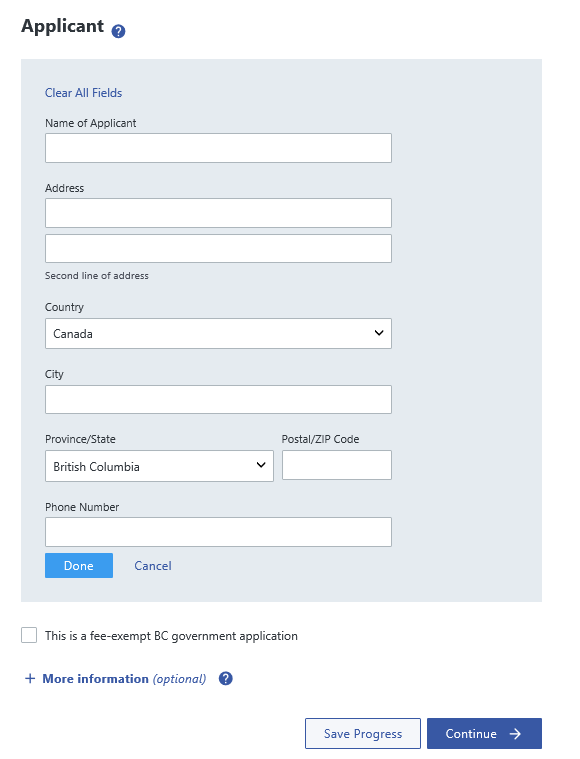
|
| 1.2 | Under the Land Title Act, the applicant is the person who is entitled to be the registered owner of the estate or interest in land charged. The applicant section on the web filing form constitutes the application to register the estate or interest in land charged and must be completed by the applicant or the solicitor or agent of the applicant either before or after execution of the instrument. |
| 1.3 | If the transferee is exempt from land title office fees, select the fee-exempt BC government checkbox. The application must be made on behalf of a ministry (name the ministry) and the ministry file must be referenced in the additional information field. |
| 1.4 | All notices (e.g. notice of receipt, notice declining to register) are sent electronically to the person who submitted the application. |
back to top of Power of Attorney
Charge, Lien, Interest or Notation
| 2.1 |
In the Select type menu, choose Power of Attorney or Representation Agreement. 
|
| 2.2 | The number field applies only to scenarios where a registered charge is assigned, postponed, or modified and does not apply to a power of attorney or representation agreement. |
| 2.3 | Complete the Add Information field to enter more details about the power of attorney or representation agreement. |
back to top of Power of Attorney
| 3.1 |
A power of attorney is filed in the power of attorney index and does not require a parcel identifier or legal description and as such, there is no PID or legal description data entry fields in web filing. The form will automatically generate the PID and Legal Description fields with not applicable. 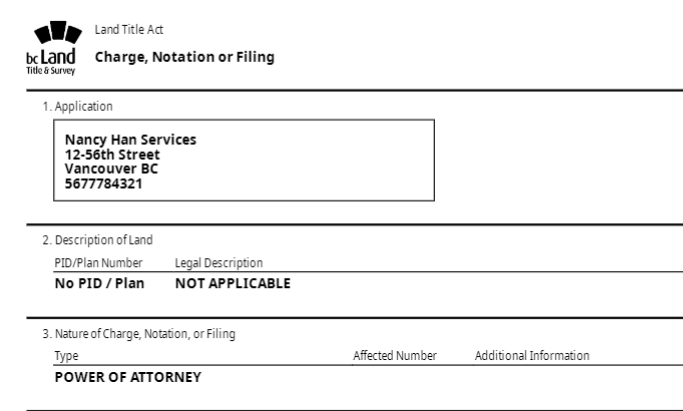
|
back to top of Power of Attorney
| 4.1 |
In the case of a Power of Attorney, the web filing data entry section automatically enters Not Applicable in the Transferee field. Although Not Applicable may be deleted, any changes to this text will not be saved on the form. The form will continue to enter Not Applicable in the Transferee field. 

|
| 4.2 | In the case of a Representation Agreement, web filing will not automatically enter Not Applicable. You may manually enter Not applicable in the name fields. EFS requires a transferee name and the system will reject the application if the transferee field is empty. |
back to top of Power of Attorney
| a. | Upload the power of attorney and include a statutory declaration regarding proof of attorney's age |
| b. |
For a representation agreement upload the representation agreement and include the following certificates:
For links to standard forms for enduring powers of attorney and representation agreements, see www2.gov.bc.ca/gov/content/health/managing-your-health/incapacity-planning. 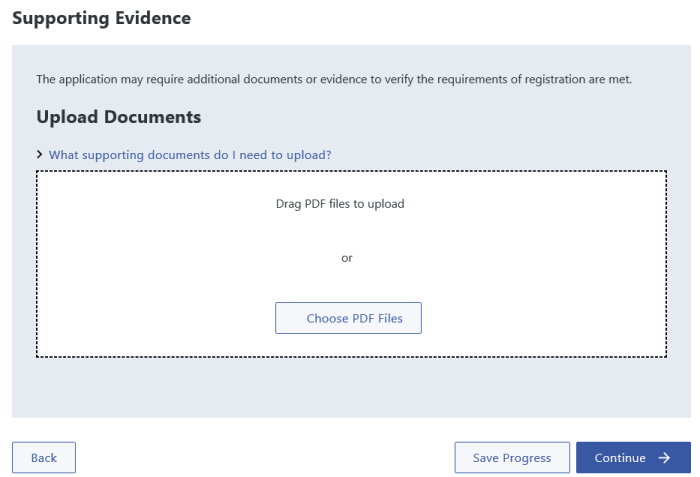
|
| c. | Where a supporting document is submitted with an electronic application, it must be a scanned image of the document that has been prepared in compliance with the scanning requirements published at Scanning Requirements. |
back to top of Power of Attorney
| a. |
After completing the data entry sections and attaching the supporting evidence, see a preview of the web filing form. You can review, validate, download, and e-sign on this page. 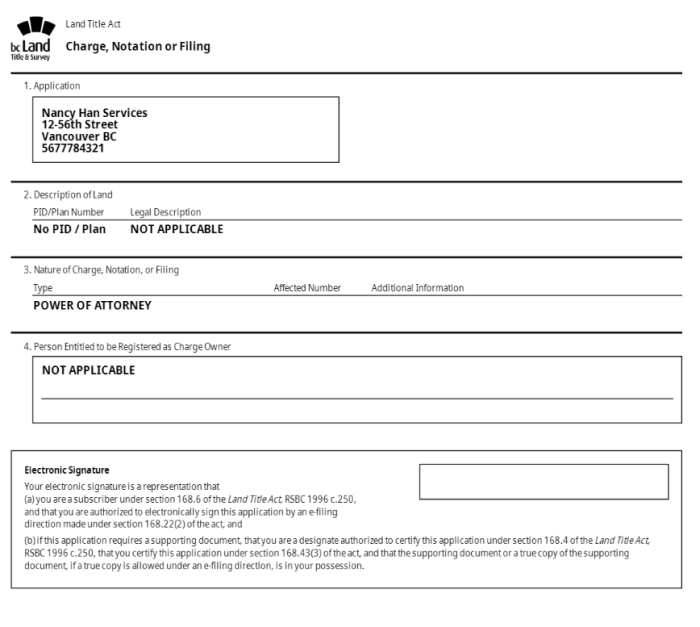
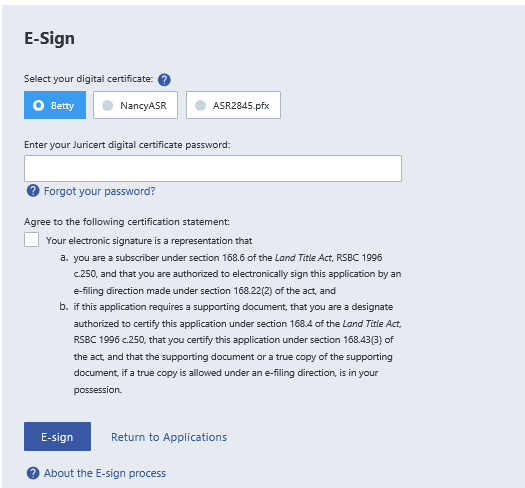
|
| b. | A British Columbia lawyer, notary or member of the Authorized Subscriber Register must e-sign the form before it can be submitted. |
| c. | Once the form is e-signed, it cannot be modified in any way without invalidating the electronic signature. |